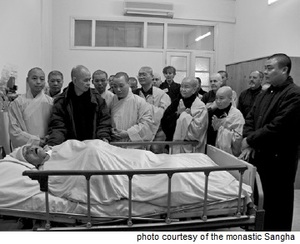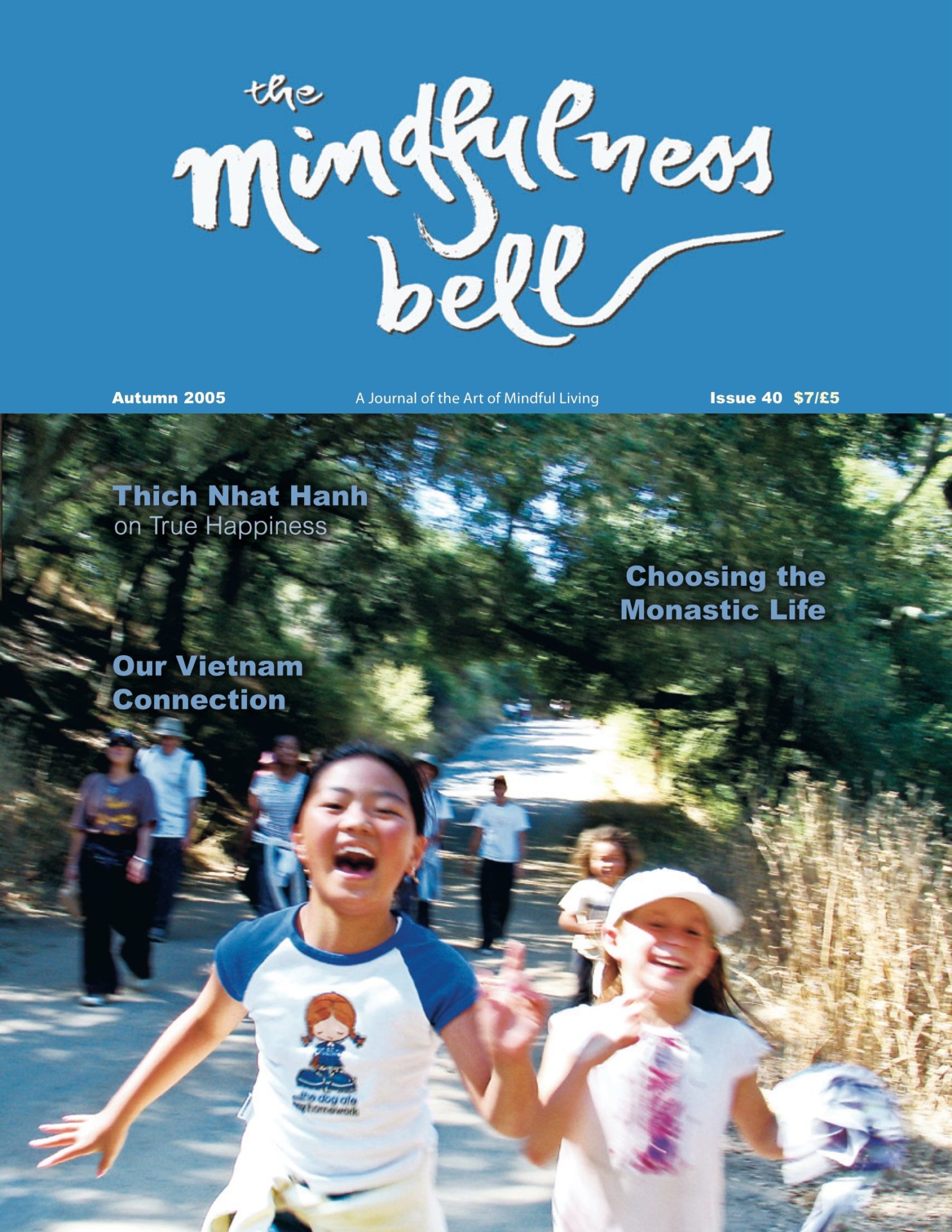By Cheryl Barnes-Neff, RN
Fourth Mindfulness Training of the Order of Interbeing:
Aware that looking deeply at the nature of suffering can help us develop compassion and find ways out of suffering, we are determined not to avoid or close our eyes before suffering. We are committed to finding ways, including personal contact, images, and sounds, to be with those who suffer, so we can understand their situation deeply and help them transform their suffering into compassion,
By Cheryl Barnes-Neff, RN
Fourth Mindfulness Training of the Order of Interbeing:
Aware that looking deeply at the nature of suffering can help us develop compassion and find ways out of suffering, we are determined not to avoid or close our eyes before suffering. We are committed to finding ways, including personal contact, images, and sounds, to be with those who suffer, so we can understand their situation deeply and help them transform their suffering into compassion, peace, and joy.

During my mentorship to join the Order of Interbeing, Ian Prattis asked my fellow aspirants and me to rewrite and discuss our personal experiences with the Fourteen Mindfulness Trainings to make them more personal and to encourage us to look at them more deeply. This is my assignment for the Fourth Mindfulness Training:
Aware that it can sometimes be easier to make excuses for or to turn my head from suffering, I vow to look deeply at the suffering in the world, even when it is painful. To look deeply into others’ suffering is to support them in a profound way by acknowledging and touching them with compassion. I vow to remember that when I look into my patients’ eyes, I am looking into the eyes of the Buddha and myself. Giving them my undivided attention will nourish us both.
I have worked in the health care fi for many years as a nurse. There have been times when I felt overwhelmed by the suffering I saw, and sometimes I distanced myself emotionally from my patients and their families. I have seen colleagues in the medical field become cold and indifferent to their patients’ suffering because they felt overwhelmed, frightened, and helpless. We see our own mortality when we face how fragile life really is.
When I first became a nurse, I worked in the Pediatric Intensive Care Unit and was helping with my first severely burned patient. It was a powerful night. I was at heightened attention as I learned new procedures and cared for a seriously injured child. There were a few moments when I was able to look into this little boy’s eyes, trying my best to comfort him, talking and singing softly to him. His big brown eyes looking out from all the white gauze touched my heart and I’ll never forget him.
After I got off work, I met my sister and we went to a meeting with a Christian group that I had promised to attend with her. I was exhausted and drained, but listened quietly. A young man told us that no one has ever suffered as much as Jesus did on the cross, and that suffering is a beautiful thing that purifies our souls.
I was horrified! In unskillful language I told them all about my night, challenging them to tell that little boy that there was some kind of suffering competition, and that what he is going through is beautiful. My sister was upset with me and my speech was not skillful or appropriate.
The incident has helped me see how sincere people avoid looking at suffering deeply by working hard to bring a positive meaning to the things that happen that are so hard to understand. We build a wall between us and another to shield ourselves from their suffering when we seek to find reasons for the suffering or positive meanings from the results instead of being with them in total presence alone. In the back of our minds, we hope that if we figure out why bad things happen we’ll know how to prevent those bad things from happening to us; if we can figure out the good that comes from the suffering, then when the bad does befall us, we’ll be okay with it. We can’t be truly mindful when in the back of our minds we’re working to figure out all the ramifications of the situation, or when we’re actually busy hoping that things will become better.
A few years ago, I helped organize a staff education session about domestic violence. I invited one of the domestic violence detectives from the local sheriff ’s office to talk with the staff about her experiences and give us another perspective on this difficult topic. She played a recording of a 911 call from a little boy, trying to get help for his mother as she was being battered by her boyfriend. Listening to the boy’s cry for help took me by surprise —as a lump gathered in my throat and tears sprang to my eyes, I realized that there were still some walls between me and this tragic human experience. By softening my heart to this little boy, and holding my pain for him quietly and looking deeply at it, I could see aspects of my own childhood that I had tried to cover over and hide from myself. My challenge was to hold the little boy, the mother, and the boyfriend in this fresh light of compassion, to see that all three of them were suffering terribly. By looking deeply at their suffering, I could touch suffering within myself, and break down one more barrier between me and others.
Thay teaches us that when we feel anger, we should hold our anger like a baby—to neither express our anger nor suppress it, but to look deeply at our feelings so that we can understand the roots of our anger. This practice has worked for me in being with patients and their families as well. When I can hold their pain and look deeply at it, I neither become consumed and overwhelmed by their pain nor do I distance myself from them. If I can be deeply present with my patients, there are no walls of judgment or separation. I can help them so much more by listening to what they need and how they feel.
Learning to be present to my patients has been a wonderful practice for me. As a nurse, I was taught to fix things, to find a symptom and do something to change it for the better. But I’ve learned that when I deeply observe and listen to them, they can tell me far more about what is wrong and what they need. Helping to ease the burden of a patient’s suffering needs to be on his or her own terms for the help to be meaningful.
It has been a privilege to be with my patients through the triumphs, tragedies, births, and deaths. Looking at suffering deeply in my patients and myself has taught me about myself, the nature of suffering, and about impermanence. While life can be so resilient, when sitting with someone as they die, the flicker of a moment between life and death feels so tender and fragile.
We can understand impermanence with our heads, but it is in looking at suffering deeply that impermanence fills our hearts.

Cheryl Barnes-Neff, True Happiness in Peace, is a hospice nurse, living in central Florida and practicing with the Laurel Oak Sangha. She was ordained into the Order of Interbeing in August.

